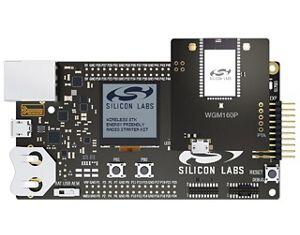WGM160P Starter Kit
Overview
The WGM160P Starter Kit SLWSTK6121A comes with the BRD4321A radio board. This radio boards contains a WGM160P module, which combines the WF200 Wi-Fi transceiver with an EFM32GG11 microcontroller.

Fig. 108 SLWSTK6121A (image courtesy of Silicon Labs)
Hardware
Advanced Energy Monitoring provides real-time information about the energy consumption of an application or prototype design.
Ultra low power 128x128 pixel color Memory-LCD
2 user buttons and 2 LEDs
Si7021 Humidity and Temperature Sensor
On-board Segger J-Link USB and Ethernet debugger
10/100Base-TX ethernet PHY and RJ-45 jack (on included expansion board)
MicroSD card slot
USB Micro-AB connector
For more information about the WGM160P and SLWSTK6121A board:
Supported Features
The efm32gg_slwstk6121a board configuration supports the following hardware features:
Interface |
Controller |
Driver/Component |
|---|---|---|
MPU |
on-chip |
memory protection unit |
COUNTER |
on-chip |
rtcc |
ETHERNET |
on-chip |
ethernet |
FLASH |
on-chip |
flash memory |
GPIO |
on-chip |
gpio |
I2C |
on-chip |
i2c port-polling |
NVIC |
on-chip |
nested vector interrupt controller |
SYSTICK |
on-chip |
systick |
UART |
on-chip |
serial port-polling; serial port-interrupt |
The default configuration can be found in the defconfig file:
boards/arm/efm32gg_slwstk6121a/efm32gg_slwstk6121a_defconfig
Other hardware features, including the WF200 WiFi transceiver, are currently not supported by the port.
Connections and IOs
The WGM160P’s EFM32GG11 SoC has six GPIO controllers (PORTA to PORTF), all of which are currently enabled for the SLWSTK6121A board.
In the following table, the column Name contains pin names. For example, PE1 means pin number 1 on PORTE, as used in the board’s datasheets and manuals.
Name |
Function |
Usage |
|---|---|---|
PA4 |
GPIO |
LED0 |
PA5 |
GPIO |
LED1 |
PD6 |
GPIO |
Push Button PB0 |
PD8 |
GPIO |
Push Button PB1 |
PE7 |
UART_TX |
UART TX Console VCOM_TX US0_TX #1 |
PE6 |
UART_RX |
UART RX Console VCOM_RX US0_RX #1 |
PB11 |
I2C_SDA |
SENSOR_I2C_SDA I2C1_SDA #1 |
PB12 |
I2C_SCL |
SENSOR_I2C_SCL I2C1_SCL #1 |
System Clock
The EFM32GG11 SoC is configured to use the 50 MHz external oscillator on the board.
Serial Port
The EFM32GG11 SoC has four USARTs, two UARTs and two Low Energy UARTs (LEUART). USART0 is connected to the board controller and is used for the console.
Programming and Debugging
Note
Before using the kit the first time, you should update the J-Link firmware from J-Link-Downloads
Flashing
The SLWSTK6121A includes an J-Link serial and debug adaptor built into the board. The adaptor provides:
A USB connection to the host computer
A physical UART connection which is relayed over interface USB serial port.
Flashing an application to SLWSTK6121A
Connect the SLWSTK6121A to your host computer using the USB port.
Here is an example to build and flash the Hello World application.
# From the root of the zephyr repository
west build -b efm32gg_slwstk6121a samples/hello_world
west flash
Open a serial terminal (minicom, putty, etc.) with the following settings:
Speed: 115200
Data: 8 bits
Parity: None
Stop bits: 1
Reset the board and you’ll see the following message on the corresponding serial port terminal session:
Hello World! efm32gg_slwstk6121a
